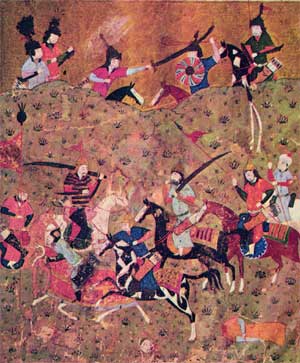Related Research Articles

Jalāl al-Dawla Mu'izz al-Dunyā Wa'l-Din Abu'l-Fatḥ ibn Alp Arslān, better known by his regnal name of Malik-Shah I, was the third sultan of the Great Seljuk Empire from 1072 to 1092, under whom the sultanate reached its zenith of power and influence.

The Buyid dynasty, also spelled Buwayhid, was a Shia Muslim Iranian dynasty of Daylamite origin, which mainly ruled over Iraq and central and southern Iran from 934 to 1062. Coupled with the rise of other Iranian dynasties in the region, the approximate century of Buyid rule represents the period in Iranian history sometimes called the 'Iranian Intermezzo' since, after the Muslim conquest of Persia, it was an interlude between the rule of the Abbasid Caliphate and the Seljuk Empire.
Abu Sa'id Taj al-Dawla Tutush or Tutush I, was the Seljuk emir of Damascus from 1078 to 1092, and sultan of Damascus from 1092 to 1094.

Abu Shuja Ghiyath al-Dunya wa'l-Din Muhammad ibn Malik-Shah, better known as Muhammad I Tapar, was the sultan of the Seljuk Empire from 1105 to 1118. He was a son of Malik-Shah I and Taj al-Din Khatun Safariya. In Turkish, Tapar means "he who obtains, finds".

Fakhr al-Din Iraqi was a Persian Sufi poet of the 13th-century. He is principally known for his mixed prose and poetry work, the Lama'at, as well as his divan, most of which were written in the form of a ghazal.

The Battle of Dandanaqan was fought in 1040 between the Seljuq Turkmens and the Ghaznavid Empire near the city of Merv. The battle ended with a decisive Seljuq victory, which subsequently brought down the Ghaznavid domination in Greater Khorasan.

The Kakuyids were a Shia Muslim dynasty of Daylamite origin that held power in western Persia, Jibal and Kurdistan. They later became atabegs (governors) of Yazd, Isfahan and Abarkuh from c. 1051 to 1141. They were related to the Buyids.

Rukn al-Din Abu'l-Muzaffar Berkyaruq ibn Malikshah, better known as Berkyaruq (برکیارق), was the fifth sultan of the Seljuk Empire from 1094 to 1105.

Persian Iraq, also uncommonly spelled Persian Irak, is a historical region of the western parts of Iran.
Sharaf ad-Dīn al-Muʿaẓẓam ʿĪsā was the Ayyubid emir of Damascus from 1218 to 1227. The son of Sultan al-Adil I and nephew of Saladin, founder of the dynasty, al-Mu'azzam was installed by his father as governor of Damascus in 1198 or 1200. After his father's death in 1218, al-Mu'azzam ruled the Ayyubid lands in Syria in his own name, down to his own death in 1227. He was succeeded by his son, an-Nasir Dawud.
The Dulafid or Dolafid dynasty was an Arab dynasty that served as governors of Jibal for the Abbasid caliphs in the 9th century. During the weakening of the authority of the caliphs after 861, their rule in Jibal became increasingly independent of the central government in Samarra. In the last decade of the 9th century, however, they were defeated by the Abbasids who proceeded to reincorporate Jibal into their empire.
Abu 'l-Fadl Muhammad ibn Abi Abdallah al-Husayn ibn Muhammad al-Katib, commonly known after his father as Ibn al-'Amid was a Persian statesman who served as the vizier of the Buyid ruler Rukn al-Dawla for thirty years, from 940 until his death in 970. His son, Abu'l-Fath Ali ibn Muhammad, also called Ibn al-'Amid, succeeded him in his office.
Muhammad ibn Ali Rawandi, was a Persian historian who wrote the Rahat al-sudur wa ayat al-surur during the fall of the Great Seljuk Empire and the subsequent invasion by the Kharwarzmian empire.
Abu'l-Qasim Darguzini, commonly known as Darguzini was a Persian bureaucrat and one of the leading figures of the Seljuk Empire in the early 12th century.

The Abbasid dynasty or Abbasids were an Arab dynasty that ruled the Abbasid Caliphate between 750 and 1258. They were from the Qurayshi Hashimid clan of Banu Abbas, descended from Abbas ibn Abd al-Muttalib. The Abbasid Caliphate is divided into three main periods: Early Abbasid era (750–861), Middle Abbasid era (861–936) and Later Abbasid era (936–1258). A cadet branch of the dynasty also ruled as ceremonial rulers for the Mamluk Sultanate as Caliph (1261–1517), until their conquest by the Ottoman Empire.
Abū Naṣr Alī ibn Hibat Allāh ibn Ja'far ibn Allakān ibn Muḥammad ibn Dulaf ibn Abī Dulaf al-Qāsim ibn ‘Īsā al-Ijlī, surnamed Sa’d al-Muluk and known as Ibn Mākūlā was a highly regarded Arab muḥaddith and historian who authored several works. His magnum opus was his biographical-genealogical history on etymology and orthography of Islamic names, Al-Ikmāl.
The Khujandi family was a Shafi'i family of religious scholars based in the city of Isfahan in central Iran, who played a leading role in Isfahani politics during the Seljuk era and up until the Mongol invasion. Their name refers to their hometown of Khujand in Transoxiana, which was then under Qarakhanid rule. The founder of the family was Abu Bakr Muhammad ibn Thabit al-Khujandi, who was appointed the head of a Shafi'i school in Isfahan by the Persian vizier of the Seljuks, Nizam al-Mulk. Owing to their origins, the Khujandis manifested a Khurasanian identity, but by the 12th-century they had adopted the western Iranian identity of the locals.
Mufaddal ibn Sa'd al-Mafarrukhi, commonly known as Mafarrukhi, was an Iranian historian who was the author of the Arabic Kitab Mahasin Isfahan, a local history of his hometown Isfahan. Modern historians generally agree that Maffarrukhi composed his work during the reign of the Seljuk sultan Malik-Shah I.
Akhbār al-dawla al-saljūqiyya is a chronicle which deals with the history of the Seljuks and the Eldiguzids. Probably written in c. 1262, it is the abridged and extant version of the original and non-extant Zubdat al-tawārīkh, which was written in Arabic by the 12th-century Iranian author Sadr al-Din Husayni.
References
- 1 2 3 4 Durand-Guédy 2013.
- ↑ Bosworth 1998, p. 538.
- 1 2 Azarnoosh 2021.